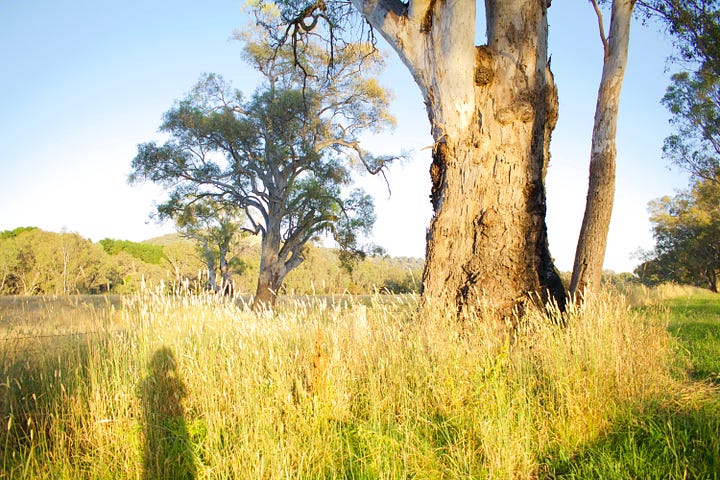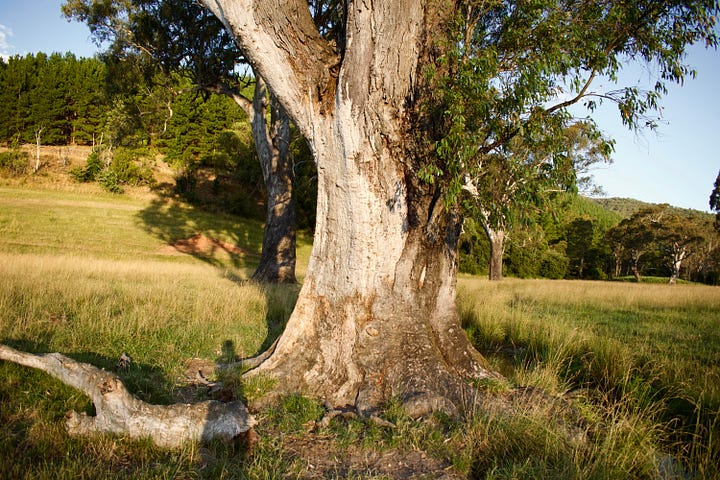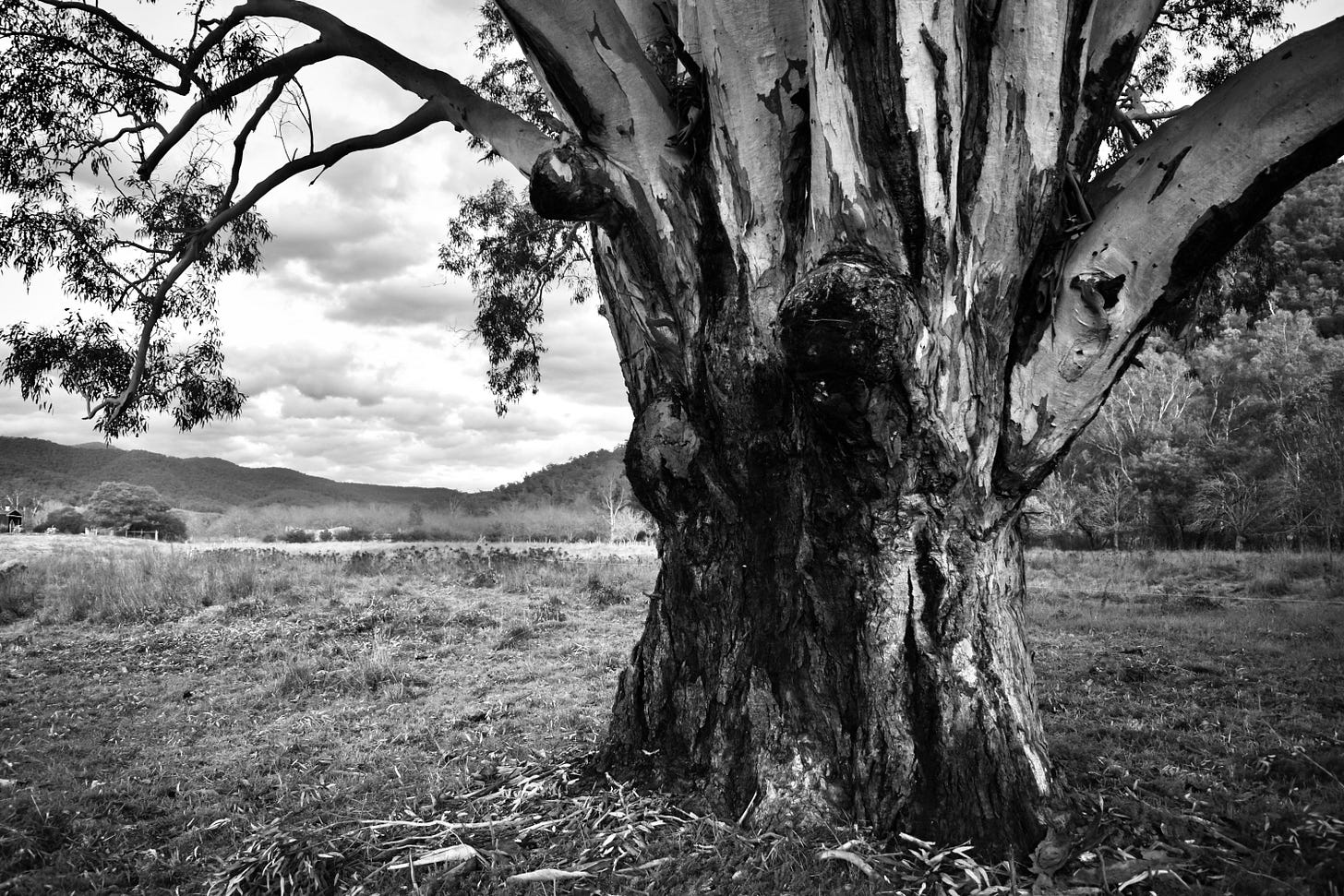The landscape on this immense southern continent has changed dramatically over the last few centuries, so much so that we may not be able to accurately conjure scenes in our imagination that reflect the reality of what it once was.
However, I have recently discovered a method of time travel facilitated by moments of connection with remnant paddock and roadside trees. Photographing and documenting these highly individual and unique trees has allowed me to walk in the forests of old, through places where these trees do not stand in isolation and where the landscapes are more vivacious and diverse.
90% of the trees I photograph are E. camaldulensis, one of this continent's most widespread eucalypt species. They are long-lived and unimaginably resilient, tolerant of flood and drought, and as my travels have shown me, soil compaction and loss of flora diversity. This resilience is undoubtedly why I’m stumbling across them more frequently than other indigenous tree species. We have come to the point where we are looking at the toughest and most adaptable species as the survivors in our landscapes. However, it wasn’t always this way.
Melissa Sweet, in her article On Relations with Trees, speaks of her childhood in central Queensland and the richness of the landscape before many thousands of acres were cleared:
“But “bush” does not do justice to the richness of its vegetation. Thick brigalow and gidgee scrub opened into box gum forests sprinkled with bauhinia trees bearing large white orchid-like flowers and spreading generous shade. There were so many grasses, so many wild flowers.” (Sweet, 2009)
What many of us imagine when we picture the rural Australian landscape, scattered trees and mostly pasture with a scattering of remaining habitat pockets here and there, is a long way removed from how the country looked only a few hundred years ago. In his wonderful article “Forgotten woodlands, future landscapes,” Ian Lunt speaks evocatively of the references he has uncovered to the many species that grew alongside Eucalypts in the forests and woodlands of long ago. He speaks of Silver Banksia and Allocasuarina (Drooping Sheoak), referred to as Honeysuckle and Oak trees in the parlance of the settlers, along with Acacia species dominating ridges and plains and harboring a cacophonous diversity of birdlife. These trees were the first to fall when European settlers began their mission to open up the country for farming purposes. He also speaks of the eroding memory of the history of our landscape, a phenomenon known as “shifting baselines syndrome”:
“The decline of the oak and honeysuckle woodlands, and our failure to recognize its scale, is a textbook example of shifting baselines syndrome. Each generation views the condition of an ecosystem when they first saw it as the new normal. We see many small losses, and know of other changes before we arrived. But we remain oblivious to how big these changes become as they accumulate over many generations. We forget the expansive, noisy woodlands of honeysuckle and oak, and remember only the locations of a few old banksias, and a few more dead plants. We picture a past landscape dominated by eucalypts, because we forget the felled species and remember the hardy and the persistent.” (Lunt, 2013)
In this context, remnant paddock and roadside trees can be seen as skeletal remains of the landscape that once was. They are the final markers on the map of history speaking of the depths of time in which the landscape has endured - they are Deep Time Trees.
These trees are of significant age and have been left to reach maturity and decline in areas where they have been beneficially overlooked. They are the lone shade-throwing sentries that save herds of sweaty sheep and cattle from the blazing summer sun. They are the individuals in pockets of roadside habitat left to age in the no-man’s land between paddock fence and road. They carry the genetic heritage of the endemic forest species in those areas sculpted by the elemental patterns unique as a fingerprint to that patch of earth. Hot winds in the summer, cold onslaughts in winter, enduring western afternoon sun, a trickle of water flow from a ridge nearby, foraging cockatoos on aging branches, the weighted pull of gravity twisting heavy limbs after winter rain. Each tree carries the signature of their place as no other before them and none to follow. They are the land expressed in tree form, centuries speaking in sculpted, living, carbon. A unique memory of the landscape is revealed in each individual tree.


In many areas I visit, the grandparent generation of trees is absent, or one or two are standing alone. The parents there are often unable to pass on their seeds in the manner that the landscape desires due to the presence of cattle or sheep, the competition of weeds, or changes in water flow. Moreover, the youngsters there are few and far between, defying the odds and surviving. When we use these trees as a portal to our imagination, we can imagine the past. If you ponder a bit longer, you’ll realise we could just as easily be looking at a view from some point in the future. These trees could be turning points within the diminishing flora of our continent; they could be markers for a burgeoning expansion of plant and animal life.
So perhaps a strange notion: old trees as past and future doorways through which we can peek into a different time and a richer landscape - and that we must use our imagination to get there? Even better. When we stretch our capacities to envisage something other than what is, we are utilising creative forces that are the seeding place of every great and inspiring act on our planet.



